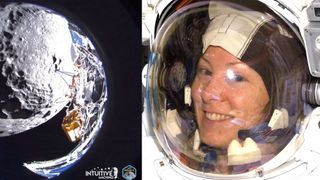
NASA astronaut Tracy C. Dyson (right) is celebrating the successful landing of the Intuitive Machines IM-1 mission bearing NASA science (left).
(Image credit: JAXA (left), NASA (right))
NASA sees an even brighter future for its human moon-landing program after a private robotic mission safely touched down last week.
Astronaut Tracy C. Dyson says NASA’s Artemis program, which aims to put boots on the moon as soon as 2026, is getting “momentum” from the private Intuitive Machines landing. That mission, known as IM-1, made the first soft U.S. lunar touchdown in 52 years this past Thursday (Feb. 22).
“It means we can do it,” Dyson told Space.com Monday (Feb. 26) in an exclusive interview before she returns to space next month. “We’re going back [to the moon], and we’ve got some momentum from this that’s going to propel us to keep moving with Artemis 2 and 3, and beyond — and all the hard things that we have ahead of us. It’s a big deal.”
Related: Missions to the moon: Past, present and future
The lander for IM-1, known as Odysseus, was the first private machine overall to soft-land on the moon, and the first U.S. vehicle to successfully do so since the crewed Apollo 17 mission in 1972.
Riding on board Odysseus are six NASA experiments under the agency’s CLPS (Commercial Lunar Payload Services) program that aims to do science ahead of the Artemis missions. Another CLPS mission, which was flown by Astrobotic’s Peregrine lander, did not make it to the moon as planned in January.
One Artemis mission is in the books already — Artemis 1, which flew around the moon with mannequins on board in late 2022. Artemis 2 should carry four astronauts on the same trajectory no earlier than 2025. Artemis 3, if all goes to plan, will touch down on the surface in 2026 or so. (Both Artemis 2 and 3 were delayed in January due to several technical issues.)

Intuitive Machines’ Odysseus lander beams home a selfie in lunar orbit on Feb. 21, 2024. (Image credit: Intuitive Machines)
The Artemis program plans to put a permanent settlement near the moon’s south pole, which is rich in water ice needed for fueling and machinery. It will build on the success of 25 years of launching astronaut crews to the International Space Station (ISS), including Dyson’s in March.
Dyson will launch from Kazakhstan aboard the Russian Soyuz MS-25 spacecraft no earlier than March 21, for a six-month stay aboard the ISS. Joining her will be Roscosmos cosmonaut Oleg Novitskiy and spaceflight participant Marina Vasilevskaya of Belarus, who will each spend 12 days in space before returning to Earth.
Dyson has already flown to orbit twice before: with space shuttle mission STS-118 on a 12-day mission to the ISS in 2007, and on Soyuz TMA 18 for a long-duration mission that served in space from April 2 through Sept. 25, 2010. She has spent 176 days in space across the two missions.
Join our Space Forums to keep talking space on the latest missions, night sky and more! And if you have a news tip, correction or comment, let us know at: [email protected].
Breaking space news, the latest updates on rocket launches, skywatching events and more!
Elizabeth Howell (she/her), Ph.D., is a staff writer in the spaceflight channel since 2022 covering diversity, education and gaming as well. She was contributing writer for Space.com for 10 years before joining full-time. Elizabeth’s reporting includes multiple exclusives with the White House and Office of the Vice-President of the United States, an exclusive conversation with aspiring space tourist (and NSYNC bassist) Lance Bass, speaking several times with the International Space Station, witnessing five human spaceflight launches on two continents, flying parabolic, working inside a spacesuit, and participating in a simulated Mars mission. Her latest book, “Why Am I Taller?”, is co-written with astronaut Dave Williams. Elizabeth holds a Ph.D. and M.Sc. in Space Studies from the University of North Dakota, a Bachelor of Journalism from Canada’s Carleton University and a Bachelor of History from Canada’s Athabasca University. Elizabeth is also a post-secondary instructor in communications and science at several institutions since 2015; her experience includes developing and teaching an astronomy course at Canada’s Algonquin College (with Indigenous content as well) to more than 1,000 students since 2020. Elizabeth first got interested in space after watching the movie Apollo 13 in 1996, and still wants to be an astronaut someday. Mastodon: https://qoto.org/@howellspace
>>> Read full article>>>
Copyright for syndicated content belongs to the linked Source : Space.com – https://www.space.com/intuitive-machines-moon-landing-artemis-tracy-dyson































